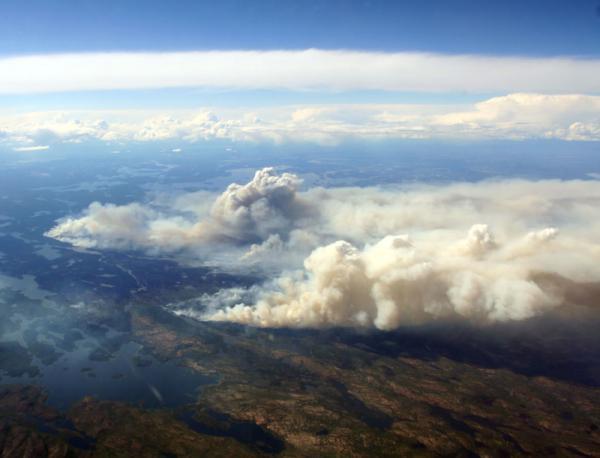Forest fire and ozone pollution
A new study concludes that forest fires can push ozone pollution to levels that exceed US health standards. The study, conducted by scientists at the National Center for Atmospheric Research (NCAR), focuses on the 2007 wildfires in California. Consecutive wildfires pushed ozone pollution to a wide range of health-damaging levels, including the California suburbs, as well as the adjacent Nevada area.
The study is published in Geophysical Research Letters. NASA, the National Science Foundation has funded research.
NCAR scientist Gabriele Pfister, the lead author, said: 'Understanding the health impact of forest fires is very important. Ozone can reach the level of health harm in places where smoke cannot be seen '.
Although scientists have known for a long time that wildfires can affect air quality by releasing magnetic and atmospheric parts into the atmosphere, research in this area is very limited. Forest fires exacerbate ozone levels by releasing nitrogen oxides and hydrocarbons, from which ozone is formed by chemical reactions in sunlight near the fire or in windy areas.
Researchers combined computer models and field surveys to study California fires in September and October 2007. They found that ozone pollution tends to violate levels. health safety is 3 times when forest fire breaks out.
At the time of wildfires, the public health standard for ozone set by the Environmental Protection Agency (EPA) was 0.008 parts per million over an eight-hour period. After that, EPA tightened this standard to 0.075 parts per million. Under stricter standards, the number of violations could double.

Forest fires like in Western Canada last summer, can pollute ozone to the point of causing health harm.(Photo: Cameron S. McNaughton)
Ozone in the stratosphere benefits life on Earth by blocking ultraviolet rays from the Sun. In contrast, ozone in the lower atmosphere can cause some health problems, from coughing and sore throat to more serious problems like asthma, bronchitis and emphysema. Ground ozone pollution also harms crops and other plants.
Pfister said: 'Forest fires are expected to deteriorate in the future, especially when the climate is warming. However, we have only just begun to understand its potential impacts on people and ecosystems, not only in areas near the fires but also in the windy areas. '
Impact on suburbs
The level of ozone harmful to health appears mostly in suburban areas. This finding could be the result of a sophisticated detailed computer model to determine the impact on dense and crowded urban areas. However, the authors also predict that forest fires have a greater effect on the level of ozone pollution in rural areas than in urban areas. The cause is chemistry.Cities often have high levels of nitrogen dioxide, high-level pollutants that can reduce the effectiveness of ozone formation or even destroy ozone.
Chrine Wiedinmyer, NCAR scientist, co-author of the paper, said: 'The impact of wildfires on ozone in the foreign area is quite obvious.'
The article also stressed that the level of ozone pollution would be more serious unless the Santa Ana winds in October blew bushfire into the Atlantic Ocean, away from residential areas.
Trace pollution
To determine the impact of wildfires on ozone formation, the researchers used two computer models developed by NCAR. With the first model, they determined the amount of trees burned and the amount of nitrogen oxides, sulfur dioxide, and other pollutants released. These results are included in the global air chemistry model that reproduces the movement of gases escaping and monitoring ozone formation when fire dust spreads in the wind.
Scientists compare the results from computer models with results from EPA's ground stations network in many locations in California. This allows them to determine excess ozone and the role of forest fires. Moreover, through which scientists can assess the accuracy of the computer model used.
- Is harmful ozone inhaled harmful?
- California sinks in 'hell fire'
- Nearly 100 hectares of Hai Van forest were destroyed
- New news of the biggest fire in Soc Son and Hanoi forests
- Shocking photos of the Amazon forest burst into record speed
- 44 people died, California forest fire has never been so horrifying
- Singapore is concerned about forest fires in Indonesia
- Terrible consequences of the Amazon forest fire
- The Amazon forest was big, and the smoke could be seen from the orbit
- Ozone causes pollution when on the ground
- The ozone hole can be healed in 2070
- Using fire to put out the fire like?
 Is the magnetic North Pole shift dangerous to humanity?
Is the magnetic North Pole shift dangerous to humanity? Washington legalizes the recycling of human bodies into fertilizer
Washington legalizes the recycling of human bodies into fertilizer Lightning stone - the mysterious guest
Lightning stone - the mysterious guest Stunned by the mysterious sunset, strange appearance
Stunned by the mysterious sunset, strange appearance